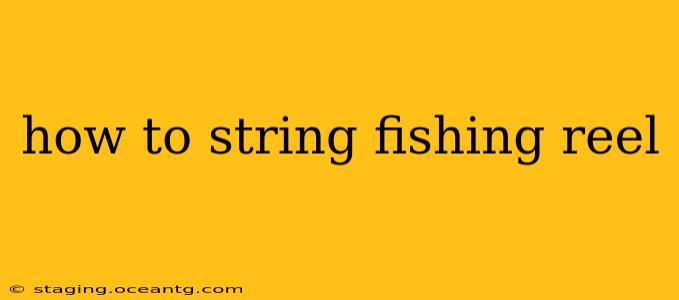Stringing a fishing reel might seem daunting at first, but with a little patience and the right technique, it becomes a straightforward process. This guide will walk you through the steps, covering various reel types and addressing common questions. Whether you're a seasoned angler or just starting out, mastering this skill will save you time and frustration on the water.
What Type of Fishing Reel Do I Have?
Before we begin, it's crucial to identify your reel type. The process varies slightly depending on whether you have a spinning reel, baitcasting reel, or spincast reel. Understanding your reel's mechanism is key to successful stringing.
Spinning Reels
Spinning reels are popular for their ease of use and versatility. They're often used for lighter fishing applications.
Baitcasting Reels
Baitcasting reels are known for their power and precision, often preferred for heavier lures and techniques. They require more skill to master than spinning reels.
Spincast Reels
Spincast reels are simple and easy to use, making them ideal for beginners. They're often used for simpler fishing situations.
How to String a Spinning Reel
This is generally considered the easiest type of reel to string.
-
Prepare Your Line: Start with a spool of fresh fishing line. Cut off a length significantly longer than what you think you'll need – it's better to have extra than to run short.
-
Attach the Line: Thread the line through the small hole at the base of the spool. This is usually found on the underside or side of the spool.
-
Fill the Spool: Carefully begin to fill the spool, holding the line taut to prevent tangles. Aim for even layering, leaving a small gap at the edge of the spool to avoid overflow.
-
Secure the Line: Once the spool is filled to the desired level, secure the line by tying a knot or using a line clip. This will prevent the line from slipping.
How to String a Baitcasting Reel
This is a more intricate process than spinning reels, requiring a more precise approach.
-
Prepare Your Line: Similar to spinning reels, start with a fresh spool of line and cut a longer length than needed.
-
Attach the Line: Feed the line through the guides, starting from the base of the spool to the tip.
-
Fill the Spool: This step requires more attention to detail. Ensure even layering to prevent tangles and optimize casting performance.
-
Secure the Line: Once filled, firmly secure the line to avoid slippage.
How to String a Spincast Reel
Spincast reels are typically very simple to string.
-
Open the Spool Cover: Locate the small cover that protects the spool.
-
Thread the Line: Insert the line through the designated opening and feed it onto the spool.
-
Close the Cover: After winding the line onto the spool, close the cover securely.
How Much Line Should I Use?
The amount of line depends on the type of fishing, the species targeted, and the water conditions. It's usually best to consult fishing line guides or your reel's instructions for specific recommendations.
What Kind of Fishing Line Should I Use?
The choice of fishing line depends on the type of fishing you are doing. There are several types available, including:
- Monofilament: A common, versatile option.
- Fluorocarbon: Less visible in the water and stronger than monofilament.
- Braided line: Very strong and thin, often used for specific techniques.
Again, consult fishing guides or your reel's instructions for recommendations.
What Happens if I Overfill My Reel?
Overfilling the reel can lead to several issues:
- Backlashes: Overfilling can create friction and make the reel more prone to backlashes (tangled line).
- Poor Casting: Overfilled spools can affect the casting distance and accuracy.
- Line Slippage: An overfilled reel might cause line slippage, reducing the efficiency of your fishing experience.
How Often Should I Respool My Reel?
The frequency of respooling depends on how often you fish and the wear and tear on your line. Check your line regularly for fraying or damage and respool as needed.
This guide provides a comprehensive overview of how to string a fishing reel. Remember to always consult your reel's manual for specific instructions and recommendations. Happy fishing!
